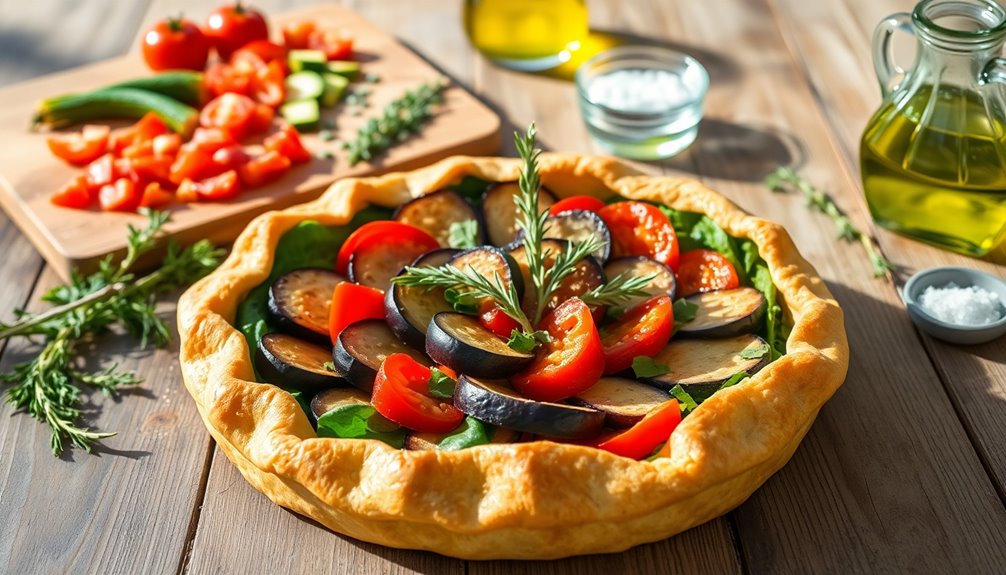Open vegetable pie, or galette, is a savory French dish featuring seasonal veggies and a flaky crust. It's perfect for warm weather and highlights the natural sweetness of ingredients like courgettes and cherry tomatoes. Making it involves a simple pastry dough, where keeping the butter cold is key. You can customize it with cheese and herbs for extra flavor. Stick around to discover tips for enhancing your pie and pairing suggestions to elevate your dining experience.
History
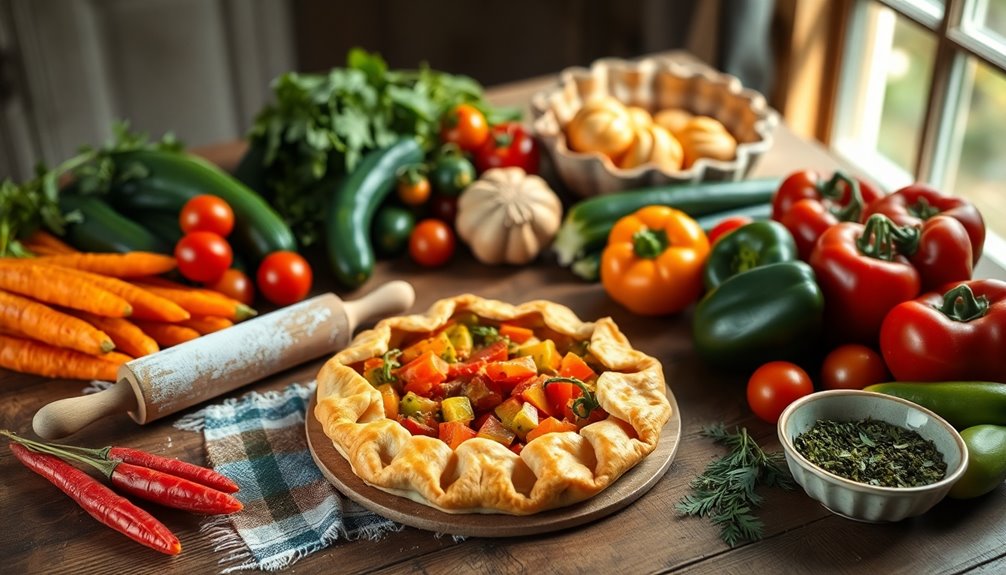
When you think about the open vegetable pie, or galette, you mightn't realize it has deep roots in French cuisine.
Historically, savory pies were a staple in medieval Europe, utilizing seasonal vegetables to create hearty meals. This concept of a pastry base dates back centuries, evolving from practical food preservation methods to a celebrated dish in modern culinary arts.
In the 19th century, the rise of cookbooks bolstered the popularity of vegetable pies, encouraging cooks to experiment with flavors and ingredients.
Today, the open vegetable pie is cherished for its versatility, often featuring locally sourced produce that highlights the changing seasons. Effective foraging strategies can enhance the selection of ingredients, making it easy to adapt this dish to suit your taste, thus making it a beloved choice in both home kitchens and restaurants.
Recipe
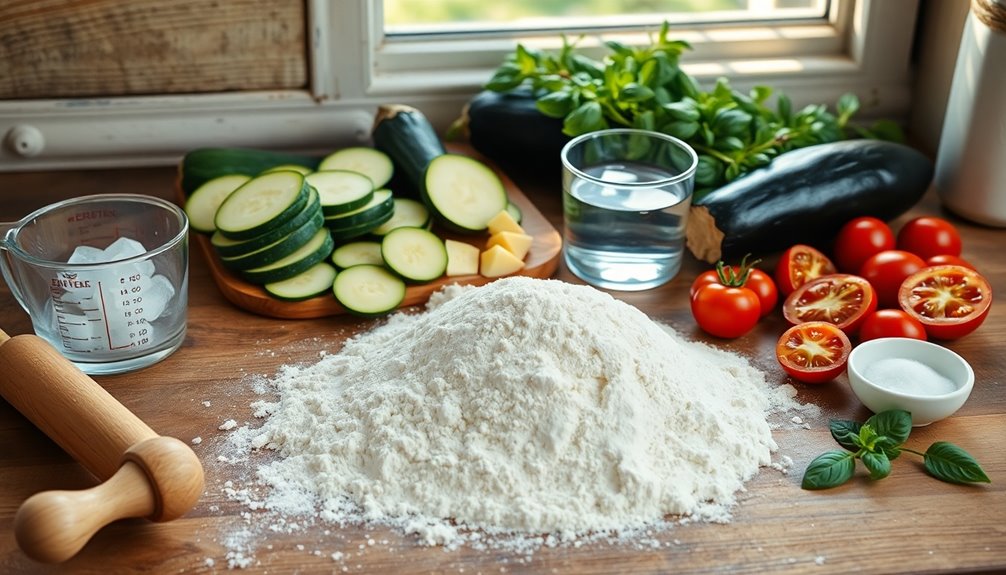
To start, you'll need to prepare a simple pastry dough that's both easy to handle and deliciously crumbly. The key to a great crust is to keep your butter cold, ensuring that the pastry bakes up light and flaky.
Once the dough is ready, it's chilled to relax the gluten before being rolled out and filled with your choice of vibrant vegetables. Roasting the veggies beforehand enhances their natural sweetness and adds depth to the pie.
Chilling the dough relaxes gluten, while roasting the veggies enhances their sweetness, creating a delicious depth of flavor.
Ingredients
- 1 cup all-purpose flour
- 1/2 cup unsalted butter (cold, diced)
- 1/4 cup lard (optional, cold, diced)
- 1/4 teaspoon salt
- 2-3 tablespoons cold water
- 2 medium courgettes (sliced)
- 1 medium aubergine (cubed)
- 1 cup cherry tomatoes (halved)
- 1-2 tablespoons olive oil
- Salt and pepper to taste
- Optional: 1/2 cup grated cheese (e.g., feta or mozzarella)
- Optional: Fresh herbs (e.g., basil, thyme)
Cooking Instructions
Begin by making the pastry: in a mixing bowl, combine the flour and salt, then cut in the cold butter and lard until the mixture resembles coarse crumbs.
Gradually add cold water, mixing until the dough comes together. Shape it into a disc, wrap in plastic, and refrigerate for 30 minutes.
Meanwhile, preheat your oven to 400°F (200°C). Toss the courgettes, aubergine, and cherry tomatoes with olive oil, salt, and pepper, then spread them on a baking sheet and roast for about 20 minutes until tender.
Roll out the chilled pastry and fit it into a pie dish, then fill it with the roasted vegetables and top with cheese and herbs if using. Bake for 35 minutes or until the crust is golden brown.
Extra Tips
For a more flavorful crust, consider adding herbs or spices directly to the pastry dough. Additionally, using well-drained soil for growing your vegetables can significantly improve their flavor and overall quality.
If you prefer a vegetarian option, skip the cheese or use a dairy-free alternative. This pie also freezes well, so you can make it ahead of time and reheat it for a quick meal.
Serve it warm or at room temperature, and pair it with a refreshing salad to enhance the meal. Enjoy your open vegetable pie as a delightful centerpiece for any gathering or a comforting dinner at home!
Cooking Steps
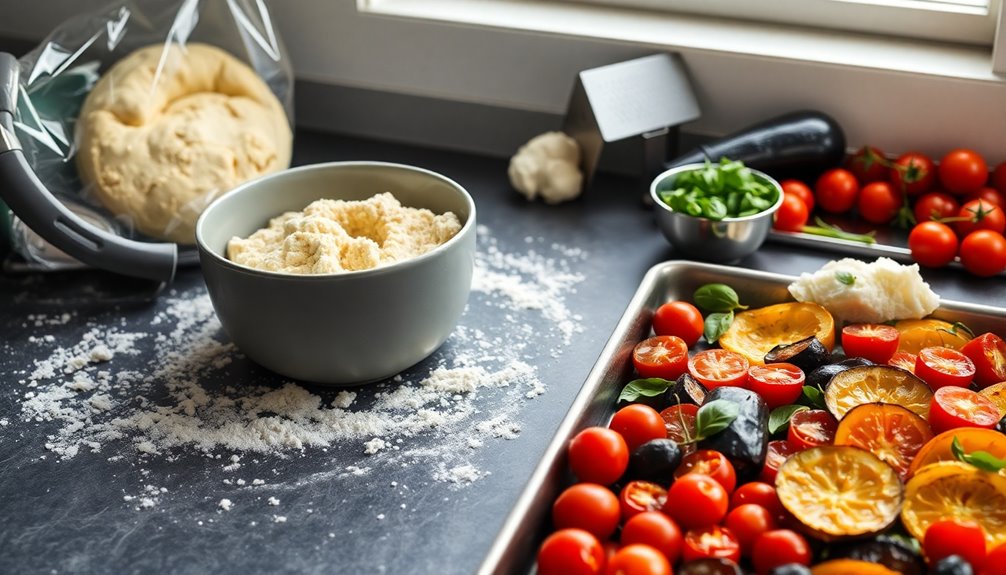
To start making your open vegetable pie, you'll want to preheat the oven to 375°F.
Next, add your roasted vegetables to the pastry and sprinkle some cheese on top for extra flavor. Incorporating nutrient-dense ingredients can enhance the overall healthiness of your dish.
Bake it all for about 30 minutes, then let it cool before slicing to enjoy.
Step 1. Preheat the Oven to 375°F
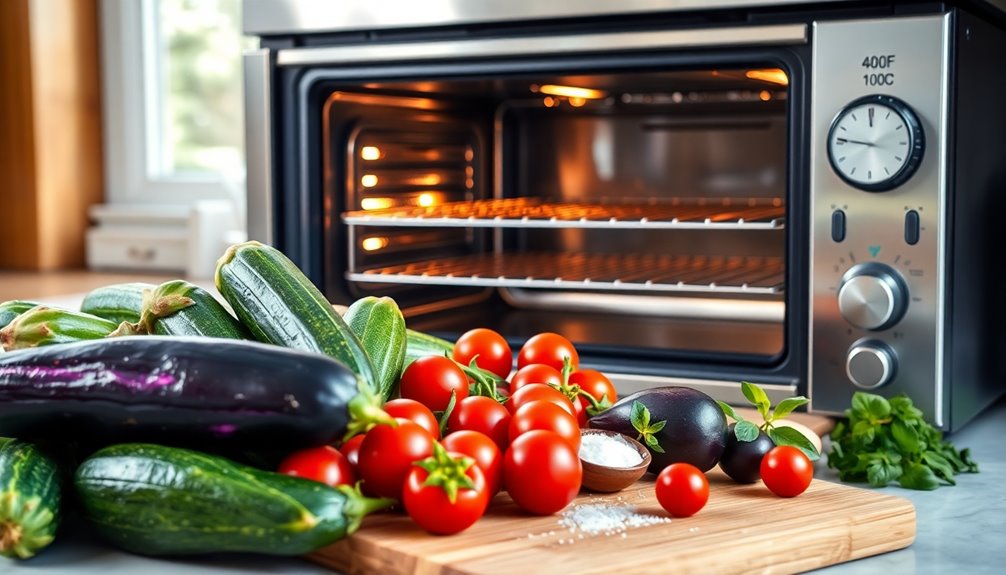
Preheating your oven to 375°F (190°C) is essential for achieving a perfectly cooked vegetable pie with a golden-brown crust.
Before you place the pie inside, make sure the oven has reached the desired temperature to avoid undercooked pastry. Preheating usually takes about 15-20 minutes, depending on your oven type and model.
To ensure accuracy, consider using an oven thermometer, as some ovens may have temperature discrepancies.
Once the oven is preheated, place the vegetable pie in the center for optimal heat circulation. This helps the pie cook evenly, ensuring every bite has that delicious, flaky crust you're aiming for. Additionally, maintaining consistent performance in baking temperature can significantly impact the final result of your pie.
Follow these steps, and you'll be on your way to creating a delightful dish!
Step 2. Add Vegetables to Pastry
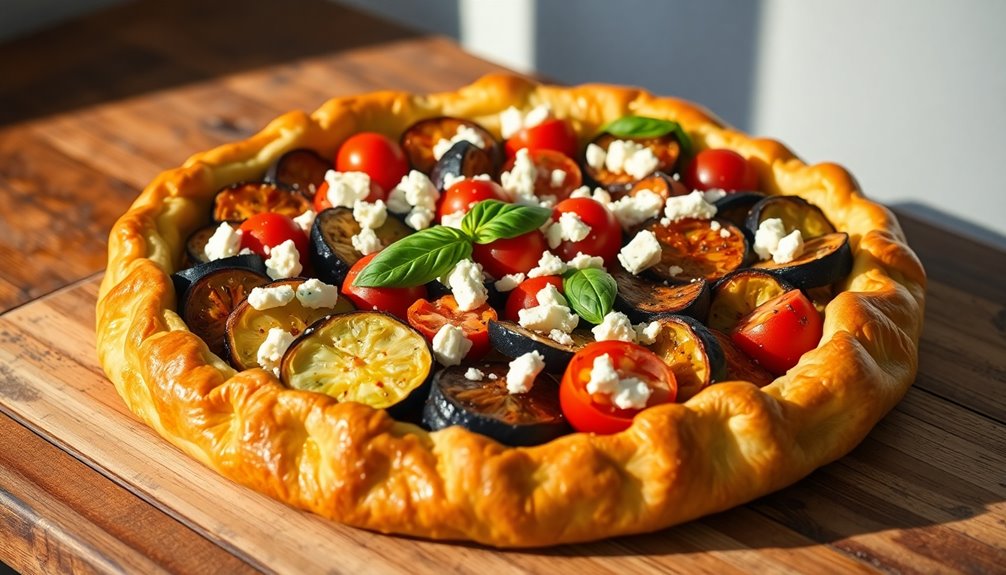
Now that your oven is warmed up, you can start adding the vegetables to the pastry.
First, roll out your chilled pastry dough on a floured surface and transfer it to a baking sheet.
Next, take your roasted vegetables—like onions, courgettes, and cherry tomatoes—that you've enhanced with oil and herbs, and layer them generously over the pastry to make the filling.
Be sure to fold up the edges of the pastry to create a rustic look for your Winter Vegetable Pie.
For a beautiful finish, brush the edges with egg wash.
Finally, bake everything for about 35 minutes until it's golden brown and delicious.
To elevate the dish further, consider serving it with a side of pumpkin bread for a sweet and spiced contrast.
Enjoy your homemade pie with vibrant flavors!
Step 3. Sprinkle Cheese on Top
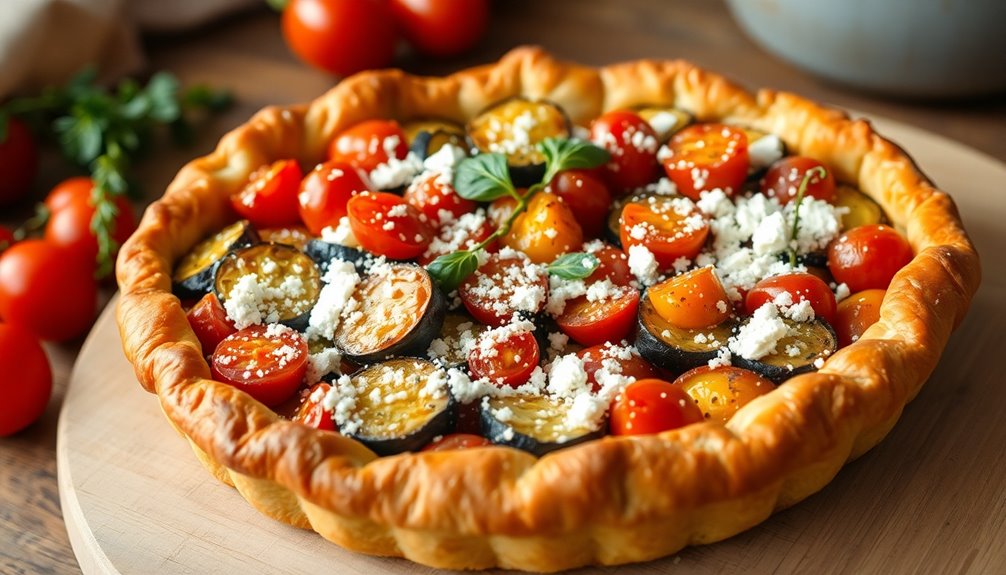
With your roasted vegetables nestled in the pastry, it's time to elevate the flavors by sprinkling cheese on top. Use about 50-100g of your favorite cheese, like Gruyère or Parmesan, to enhance the flavor without overpowering the vegetables.
Make sure to distribute the cheese evenly over the filling, ensuring a uniform melt and texture as it bakes. If you're looking for a lighter option, consider low-fat cheese or nutritional yeast for that cheesy flavor without the extra calories. A light and healthy alternative is to add some fresh herbs for an extra burst of flavor.
For an extra touch, broil the pie for the last few minutes of baking. Keep a close eye on it to prevent burning, and enjoy that delicious, golden crust that perfectly complements your vegetable filling!
Step 4. Bake for 30 Minutes
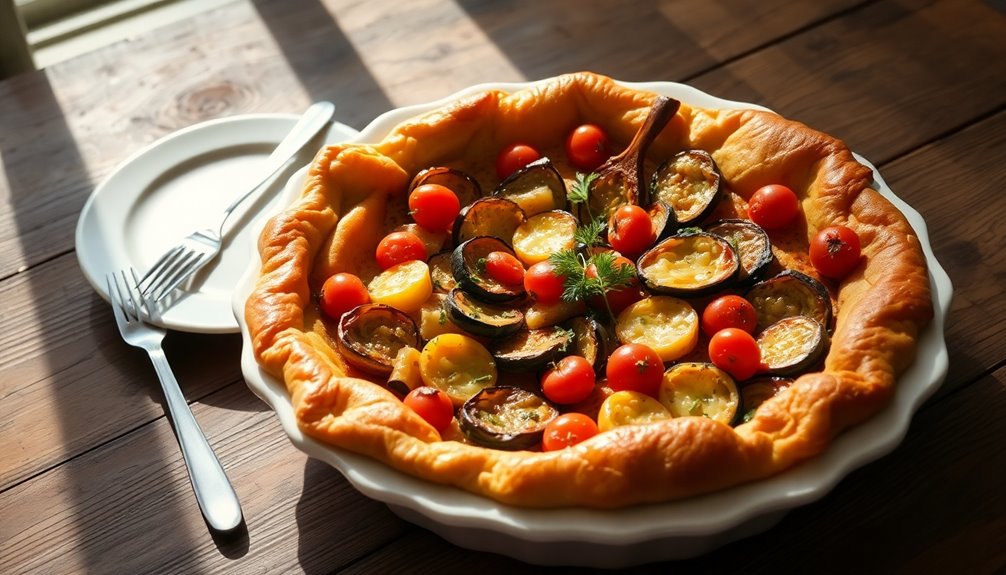
As the oven reaches the perfect temperature of 200°C (180°C fan)/400°F/gas mark 6, you can prepare to bake your open vegetable pie.
After brushing the pastry edges with egg wash for that golden finish, it's time to bake.
Carefully place your pie in the oven and set a timer to bake for 30 minutes.
Keep an eye on it during this time; you're looking for a golden brown and flaky pastry.
Check the filling's doneness by ensuring it's heated through, with any cheese melted and slightly bubbling.
If you want, you can drizzle a bit of olive oil over the top for extra flavor, and don't forget to season your filling with salt and pepper for that perfect taste.
To enhance the nutrition of your filling, consider adding red lentils as they are high in protein and fiber.
Step 5. Let Cool Before Slicing
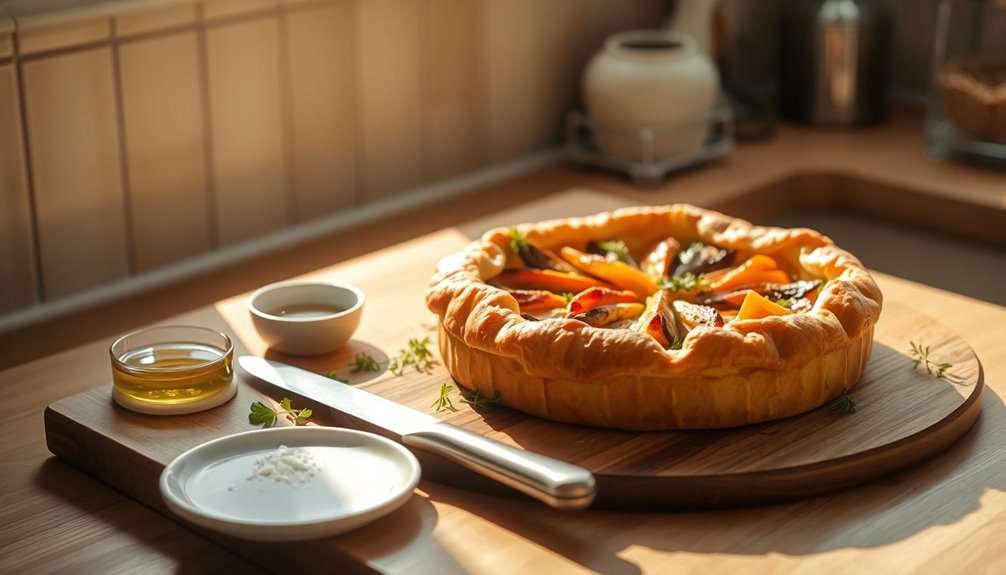
Letting your open vegetable pie cool for at least 10-15 minutes after baking is crucial for achieving the best texture and presentation.
By allowing it to cool, you let the filling set, which helps maintain its structure when you slice it. If you slice the pie while it's still hot, you risk a mushy texture and messy portions. Cooling the pie ensures cleaner portions and prevents the hot filling from spilling out.
Additionally, this resting time can enhance the flavors as the ingredients meld together. For the best results, serve your pie warm or at room temperature after it's cooled. This way, you'll truly appreciate the overall presentation and the delightful taste of your dish. As with cleaning leather sofas, taking the time to let your dish rest can significantly improve the final outcome.
Final Thoughts
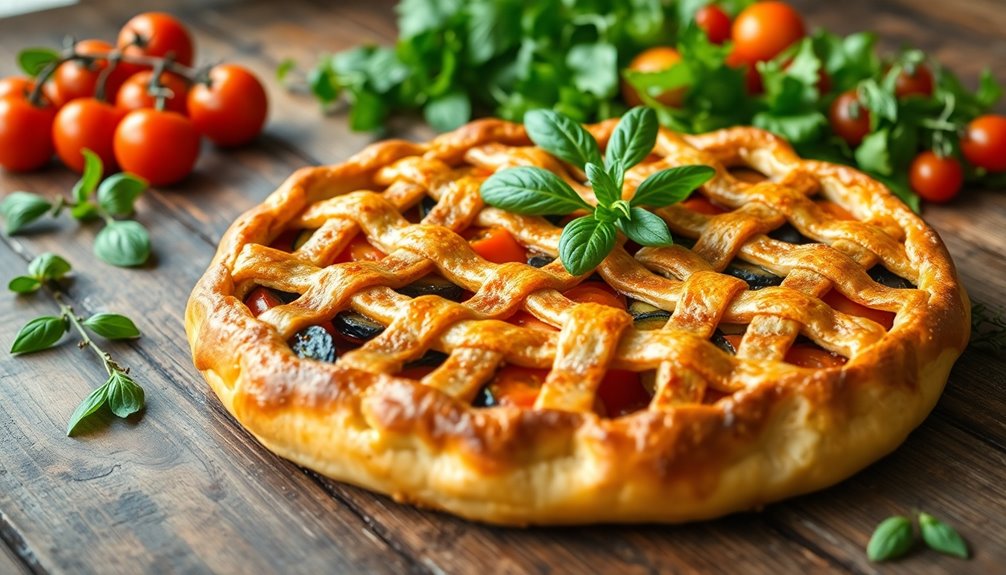
While you may think of pie as a sweet dessert, an open vegetable pie offers a delightful savory option that's perfect for any occasion.
Featuring a rustic crust made from all-purpose flour, this dish beautifully showcases fresh summer vegetables like courgettes, aubergines, and cherry tomatoes. Roasting the vegetables enhances their natural sweetness, creating a satisfying meal that's ideal for warm weather.
Plus, the open format is versatile, allowing you to add various cheeses and herbs to elevate the flavors. Whether you serve it warm or at room temperature, it's a treat.
With leftovers easily stored in the refrigerator for up to three days, it's a fantastic choice for meal prep and quick weeknight dinners. Enjoy the simplicity and deliciousness! Additionally, serving it alongside a protein-rich start can make for a more balanced breakfast or lunch option.
Frequently Asked Questions
What Is an Open Pie Called?
An open pie is often called a galette or tart, depending on its style.
Galettes are rustic and free-form, showcasing seasonal ingredients, while tarts feature a more defined edge and refined presentation.
You might also hear the term "open-faced pie," which can refer to dishes like quiches.
These versatile creations allow you to experiment with various fillings, making them perfect for both sweet and savory delights in your kitchen.
How Long Does Vegetable Pie Last in Fridge?
You might wonder how long a vegetable pie lasts in the fridge.
Generally, it can stay fresh for about 3 to 4 days if you store it properly. Make sure you keep it in an airtight container to lock in moisture and flavor.
If your pie has dairy, be extra cautious about timing to avoid spoilage. For the best taste, try to eat your leftovers within the first couple of days after baking.
How Do You Make a Pie Lid?
To make a pie lid, you'll start by rolling out chilled pastry dough on a floured surface until it's about 3mm thick.
Make sure it's slightly larger than your pie dish for easy crimping. Cut slits in the lid for steam to escape, preventing sogginess.
Brush it with an egg wash for a golden finish. Finally, chill the pie in the refrigerator for 30 minutes before baking to maintain its shape and texture.
What Is Romany Homity Pie?
Did you know that over 90% of the ingredients in Romany Homity Pie can be found in a typical kitchen?
This traditional British dish, rooted in the Romany gypsy community, features a creamy filling of mashed potatoes, onions, and cheese, often seasoned with herbs.
You'll love its hearty flavor and rustic charm, all encased in a shortcrust pastry.
Enjoy it warm as a main dish or a versatile side!
Conclusion
As you savor each bite of your open vegetable pie, let the vibrant flavors dance on your palate like a joyful celebration. This dish isn't just a meal; it's a tapestry woven from history and creativity, a testament to the beauty of fresh ingredients. With every slice, you've not only fed your body but also nourished your soul. So, gather your loved ones, share this delightful creation, and watch as laughter and warmth fill the air around your table.
